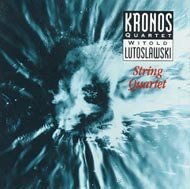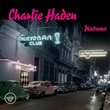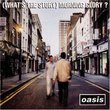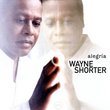| All Artists: Hank Dutt, David Harrington, Joan Jeanrenaud, John Sherba, Kronos Quartet Title: Witold Lutoslawski: String Quartet (1964) - Kronos Quartet Members Wishing: 1 Total Copies: 0 Label: Nonesuch Release Date: 1/16/1991 Genres: Jazz, Classical Styles: Avant Garde & Free Jazz, Chamber Music Number of Discs: 1 SwapaCD Credits: 1 UPCs: 075597925524, 075597925548 |
Search - Hank Dutt, David Harrington, Joan Jeanrenaud :: Witold Lutoslawski: String Quartet (1964) - Kronos Quartet
 | Hank Dutt, David Harrington, Joan Jeanrenaud Witold Lutoslawski: String Quartet (1964) - Kronos Quartet Genres: Jazz, Classical
|
Larger Image |
CD DetailsSimilarly Requested CDs
|
CD ReviewsAn extraordinary experience. Mark Grindell | Shipley,West Yorkshire | 04/28/2003 (5 out of 5 stars) "I had the unspeakable privilege of meeting Mr Lutoslawski in the year 1981, and it remains for me a memory that I will treasure always. He was a little man, very dapper and neat, and he had an impeccable English accent. I met him in the bar in the basement of St Johns Smith Square in London after a performance of his second symphony. Now, to be frank I had really idolised the fellow, having heard much of his work, and the funny thing was that after all this time, and face to face with the man, I couldn't really think of much to say. I wanted to ask, what does the secnd movement mean? What does it represent? I'm glad though, that I didn't. I'm also sorry I didn't, then the answer could appear here.I obtained an answer of a sort from remembering Leonard Bersteins comment about music being its own metaphor. Perhaps any answer would have been misleading. Perhaps I'm a traitor and would wish forever to actually ask.To technical details. The quartet is printed on a complicated system of fold out pages, some of which are LARGE. In any case, the score need very careful handling, the Polish edition I had had quite fragile paper.It's comprised of a series of architectural entities, "mobiles" in Witolds own words, which make a certain sound and the succession of which convey a kind of progression. I don't use the word journey - I can't explain why.The music is relatively easy to play. Even the first violin part is written in such a way that the high notes are mostly stopped harmonics rather than actual high notes. The actual composition is definitely the sort of atonal work of the mid century style that may or may not contain underlying series. My suspicion is that the series is actually the ascending series of semitones, no less. I'm serious - this may be the only work to use this series.The thematic material is definitely a study of the semitone interval, explored in itself, expanded, vastly distended and amplified over the landscape of the terrifying second movements first page (which is lengthy), and then presented as scattered, twinkling fragments of light over the closing movements.What is the quartet though? This virtually defies any description. Most commentators have reduced their description to a technical description of the aleatory nature of the counterpoint. The piece is not really intended to be repeated exactly, and there are no bar lines, or metronome marks, and its basically a matter of chance how the parts fit together exactly.The players have a complicated system of cues, carefully explained in the score, in which one mobile finishes when one player finishes a particular line, signalling the beginning of the next mobile. But again, what is the piece saying? It's certainly frightening and unsettling. Sometimes it seems to speak of some lonely place, some singular event, but as the piece unfolds into crisis and struggle, there is none of the expected resolution that might yield a kind of Webernian equilibrium. There is, though a kind of feeling of one episode of lesser disquiet following another, to a kind of colourful, chromatic familiarity. And then, a section appears which is actually marked as "March Funebre". This, of all sections is less disturbing than the preceeding material, sad, terrible really, but a kind of consolidation of grief, a kind of resolution into kindness. Then the piece ends via a series of transitions, softly and mysteriously. Lutoslawski remarks on the score that "no-one really knows who ends the piece".It's true. The piece is nothing but a distillation of the inquiet and unsettled, finally affording a reprise of the initial span of notes (a full chromatic scale, but distributed over different octaves, which is an amazing effect). Perhaps there is somthing of an equilibrium here.When I was a boy, hearing this for the first time at age 17, I doubt if in any case I could have completely comprehended this in the same way I understand any of Beethovens last quartets now. I'm different now, and grown up.This piece most emphatically does not possess the disturbing and horrifying kind of quality that, say, Shostakovich's last quartet has. This is a different kind of canvas, one in which dramatic flourishes do not always indicate emotional extremis, but perhaps a kind of impressionistic complexity.There is no great anger in the piece, but there is most certainly vigour and a kind of defiance. Certainly an inventive and most incisive musical mind - and I think Lutoslawski will be remembered that way, as someone who may be many things, a folklorist, a note painter, a creator of huge canvasses of colour, but above all, a most intelligent, eloquent, and formidable man. I will miss him tremendously." Strings addicts! Here is your manna! lianas | St. Louis, MO United States | 09/25/2000 (5 out of 5 stars) "Not only is Kronos Quartet one of the greatest ways to access modern string quartet composition (and more) but this disc featuring one of Polands great composers is a short but sweet gem of his work. If you have aleady discovered Krzysztof Penderecki or Karol Szymanowski (even Edjar Varese or Gyorgy Ligeti, neither of whom are Polish), Witold Lutoslawski must be your next composer to meet. Here is an inexpensive and excellent chance to meet him." Yes! lianas | 07/17/2004 (5 out of 5 stars) "This composition is a real good time to listen to. It is abounded in chaos, though it still maintains a dynamic structure. This album rocked my pants off, that's for damn sure. Beautiful, creepy music."
|

 Track Listings (2) - Disc #1
Track Listings (2) - Disc #1




